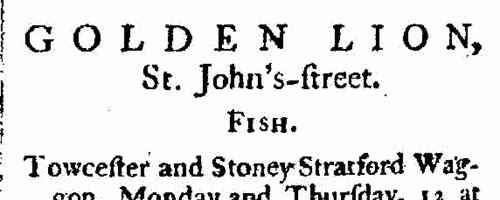Our indexes include entries for the spelling bayliss. In the period you have requested, we have the following 358 records (displaying 31 to 40):
 Masters of clerks and apprentices
(1778) Masters of clerks and apprentices
(1778)
Apprenticeship indentures and clerks' articles were subject to a 6d or 12d per pound stamp duty: the registers of the payments usually give the master's trade, address, and occupation, and the apprentice's name, as well as details of the date and length of the apprenticeship. 2 January to 25 August 1778. IR 1/29 | Sample scan, click to enlarge

|
 Clerks and apprentices
(1779) Clerks and apprentices
(1779)
Apprenticeship indentures and clerks' articles were subject to a 6d or 12d per pound stamp duty: the registers of the payments usually give the master's trade, address, and occupation, and the apprentice's name, as well as details of the date and length of the apprenticeship. 2 January to 31 December 1779. IR 1/30 | Sample scan, click to enlarge

|
 Clerks and apprentices
(1783) Clerks and apprentices
(1783)
Apprenticeship indentures and clerks' articles were subject to a 6d or 12d per pound stamp duty: the registers of the payments usually give the master's trade, address, and occupation, and the apprentice's name, as well as details of the date and length of the apprenticeship. 23 June to 31 December 1783. IR 1/32 | Sample scan, click to enlarge

|
Soldiers, administrators, refugees and merchants in America
(1783)
These are the headquarters papers of sir Guy Carleton, British commander-in-chief at the end of the American war of independence. Many of the individuals recorded were part of the British military administration, but others are refugees and merchants whose lives had been disrupted by the conflict. These records cover April to December 1783. | Sample scan, click to enlarge

|
 Clerks and apprentices
(1784) Clerks and apprentices
(1784)
Apprenticeship indentures and clerks' articles were subject to a 6d or 12d per pound stamp duty: the registers of the payments usually give the master's trade, address, and occupation, and the apprentice's name, as well as details of the date and length of the apprenticeship. 2 January to 31 December 1784. IR 1/32 | Sample scan, click to enlarge

|
 Apprentices and clerks
(1789) Apprentices and clerks
(1789)
Apprenticeship indentures and clerks' articles were subject to a 6d or 12d per pound stamp duty: the registers of the payments usually give the master's trade, address, and occupation, and the apprentice's name, as well as details of the date and length of the apprenticeship. 2 January to 31 December 1789. IR 1/34 | Sample scan, click to enlarge

|
 Apprentices and clerks
(1791) Apprentices and clerks
(1791)
Apprenticeship indentures and clerks' articles were subject to a 6d or 12d per pound stamp duty: the registers of the payments usually give the master's trade, address, and occupation, and the apprentice's name, as well as details of the date and length of the apprenticeship. 5 March to 31 December 1791. IR 1/35 | Sample scan, click to enlarge

|
London innkeepers and coach proprietors
(1791)
A list of the different London inns (each with the surname of the innkeeper), the proprietors of the coaches, machines, diligences and waggons going from each, and their hours of setting out, from the Universal British Directory | Sample scan, click to enlarge

|
 Apprentices and clerks
(1792) Apprentices and clerks
(1792)
Apprenticeship indentures and clerks' articles were subject to a 6d or 12d per pound stamp duty: the registers of the payments usually give the master's trade, address, and occupation, and the apprentice's name, as well as details of the date and length of the apprenticeship. 2 January to 31 December 1792. IR 1/35 | Sample scan, click to enlarge

|
 Apprentices registered in Herefordshire
(1792) Apprentices registered in Herefordshire
(1792)
Apprenticeship indentures and clerks' articles were subject to a 6d or 12d per pound stamp duty: the registers of the payments usually give the master's trade, address, and occupation, and the apprentice's name, as well as details of the date and length of the apprenticeship. There are central registers for collections of the stamp duty in London, as well as returns from collectors in the provinces. These collectors generally received duty just from their own county, but sometimes from further afield. The indentures themselves can date from a year or two earlier than this return. (The sample entry shown on this scan is taken from a Bristol return. Each entry has two scans, the other being the facing page with the details of the indenture, length of service, and payment of duty.) IR 1/66 | Sample scan, click to enlarge

|
Research your ancestry, family history, genealogy and one-name study by direct access to original records and archives indexed by surname.












